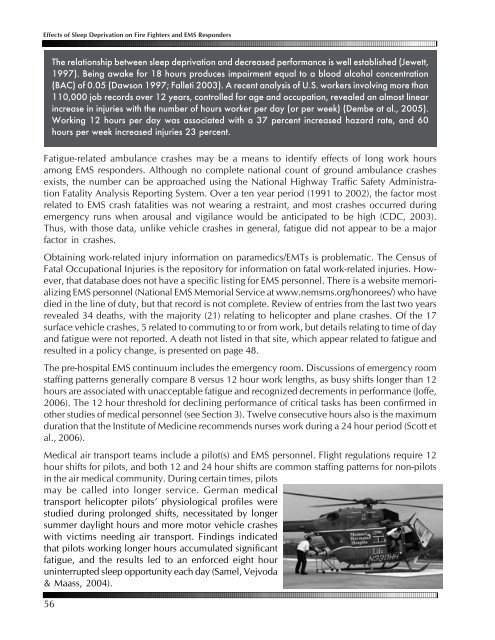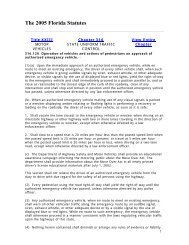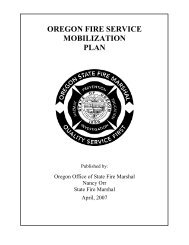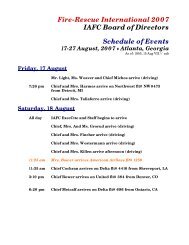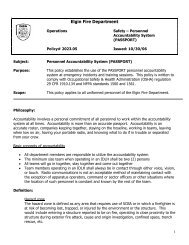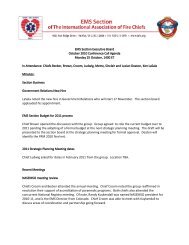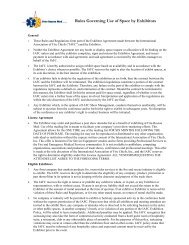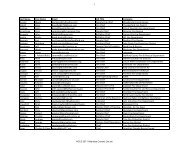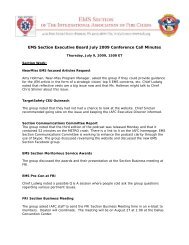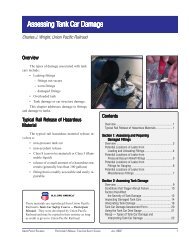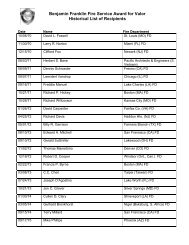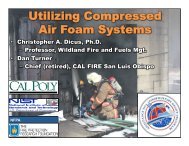Effects of Sleep Deprivation on Fire Fighters and EMS ... - NAEMT
Effects of Sleep Deprivation on Fire Fighters and EMS ... - NAEMT
Effects of Sleep Deprivation on Fire Fighters and EMS ... - NAEMT
You also want an ePaper? Increase the reach of your titles
YUMPU automatically turns print PDFs into web optimized ePapers that Google loves.
<str<strong>on</strong>g>Effects</str<strong>on</strong>g> <str<strong>on</strong>g>of</str<strong>on</strong>g> <str<strong>on</strong>g>Sleep</str<strong>on</strong>g> <str<strong>on</strong>g>Deprivati<strong>on</strong></str<strong>on</strong>g> <strong>on</strong> <strong>Fire</strong> <strong>Fighters</strong> <strong>and</strong> <strong>EMS</strong> Resp<strong>on</strong>ders<br />
The relati<strong>on</strong>ship between sleep deprivati<strong>on</strong> <strong>and</strong> decreased performance is well established (Jewett,<br />
1997). Being awake for 18 hours produces impairment equal to a blood alcohol c<strong>on</strong>centrati<strong>on</strong><br />
(BAC) <str<strong>on</strong>g>of</str<strong>on</strong>g> 0.05 (Daws<strong>on</strong> 1997; Falleti 2003). A recent analysis <str<strong>on</strong>g>of</str<strong>on</strong>g> U.S. workers involving more than<br />
110,000 job records over 12 years, c<strong>on</strong>trolled for age <strong>and</strong> occupati<strong>on</strong>, revealed an almost linear<br />
increase in injuries with the number <str<strong>on</strong>g>of</str<strong>on</strong>g> hours worker per day (or per week) (Dembe at al., 2005).<br />
Working 12 hours per day was associated with a 37 percent increased hazard rate, <strong>and</strong> 60<br />
hours per week increased injuries 23 percent.<br />
Fatigue-related ambulance crashes may be a means to identify effects <str<strong>on</strong>g>of</str<strong>on</strong>g> l<strong>on</strong>g work hours<br />
am<strong>on</strong>g <strong>EMS</strong> resp<strong>on</strong>ders. Although no complete nati<strong>on</strong>al count <str<strong>on</strong>g>of</str<strong>on</strong>g> ground ambulance crashes<br />
exists, the number can be approached using the Nati<strong>on</strong>al Highway Traffic Safety Administrati<strong>on</strong><br />
Fatality Analysis Reporting System. Over a ten year period (1991 to 2002), the factor most<br />
related to <strong>EMS</strong> crash fatalities was not wearing a restraint, <strong>and</strong> most crashes occurred during<br />
emergency runs when arousal <strong>and</strong> vigilance would be anticipated to be high (CDC, 2003).<br />
Thus, with those data, unlike vehicle crashes in general, fatigue did not appear to be a major<br />
factor in crashes.<br />
Obtaining work-related injury informati<strong>on</strong> <strong>on</strong> paramedics/EMTs is problematic. The Census <str<strong>on</strong>g>of</str<strong>on</strong>g><br />
Fatal Occupati<strong>on</strong>al Injuries is the repository for informati<strong>on</strong> <strong>on</strong> fatal work-related injuries. However,<br />
that database does not have a specific listing for <strong>EMS</strong> pers<strong>on</strong>nel. There is a website memorializing<br />
<strong>EMS</strong> pers<strong>on</strong>nel (Nati<strong>on</strong>al <strong>EMS</strong> Memorial Service at www.nemsms.org/h<strong>on</strong>orees/) who have<br />
died in the line <str<strong>on</strong>g>of</str<strong>on</strong>g> duty, but that record is not complete. Review <str<strong>on</strong>g>of</str<strong>on</strong>g> entries from the last two years<br />
revealed 34 deaths, with the majority (21) relating to helicopter <strong>and</strong> plane crashes. Of the 17<br />
surface vehicle crashes, 5 related to commuting to or from work, but details relating to time <str<strong>on</strong>g>of</str<strong>on</strong>g> day<br />
<strong>and</strong> fatigue were not reported. A death not listed in that site, which appear related to fatigue <strong>and</strong><br />
resulted in a policy change, is presented <strong>on</strong> page 48.<br />
The pre-hospital <strong>EMS</strong> c<strong>on</strong>tinuum includes the emergency room. Discussi<strong>on</strong>s <str<strong>on</strong>g>of</str<strong>on</strong>g> emergency room<br />
staffing patterns generally compare 8 versus 12 hour work lengths, as busy shifts l<strong>on</strong>ger than 12<br />
hours are associated with unacceptable fatigue <strong>and</strong> recognized decrements in performance (J<str<strong>on</strong>g>of</str<strong>on</strong>g>fe,<br />
2006). The 12 hour threshold for declining performance <str<strong>on</strong>g>of</str<strong>on</strong>g> critical tasks has been c<strong>on</strong>firmed in<br />
other studies <str<strong>on</strong>g>of</str<strong>on</strong>g> medical pers<strong>on</strong>nel (see Secti<strong>on</strong> 3). Twelve c<strong>on</strong>secutive hours also is the maximum<br />
durati<strong>on</strong> that the Institute <str<strong>on</strong>g>of</str<strong>on</strong>g> Medicine recommends nurses work during a 24 hour period (Scott et<br />
al., 2006).<br />
Medical air transport teams include a pilot(s) <strong>and</strong> <strong>EMS</strong> pers<strong>on</strong>nel. Flight regulati<strong>on</strong>s require 12<br />
hour shifts for pilots, <strong>and</strong> both 12 <strong>and</strong> 24 hour shifts are comm<strong>on</strong> staffing patterns for n<strong>on</strong>-pilots<br />
in the air medical community. During certain times, pilots<br />
may be called into l<strong>on</strong>ger service. German medical<br />
transport helicopter pilots’ physiological pr<str<strong>on</strong>g>of</str<strong>on</strong>g>iles were<br />
studied during prol<strong>on</strong>ged shifts, necessitated by l<strong>on</strong>ger<br />
summer daylight hours <strong>and</strong> more motor vehicle crashes<br />
with victims needing air transport. Findings indicated<br />
that pilots working l<strong>on</strong>ger hours accumulated significant<br />
fatigue, <strong>and</strong> the results led to an enforced eight hour<br />
uninterrupted sleep opportunity each day (Samel, Vejvoda<br />
& Maass, 2004).<br />
56


